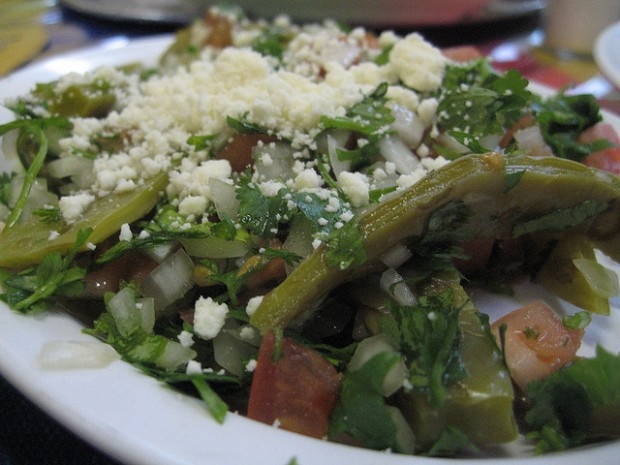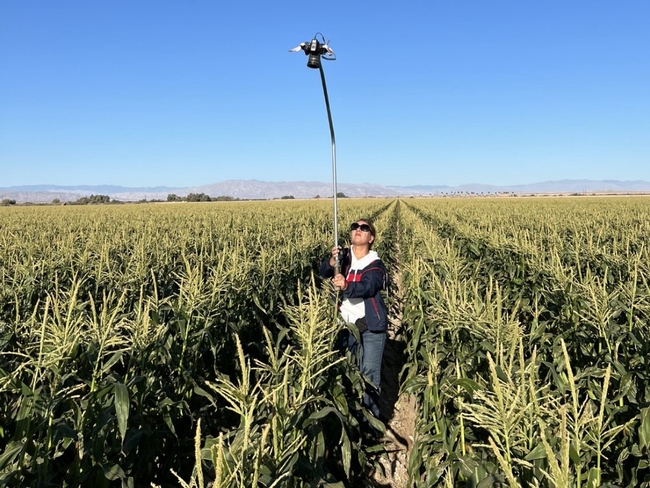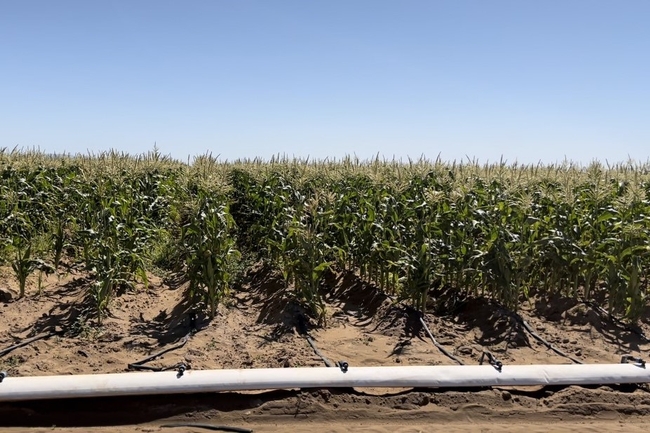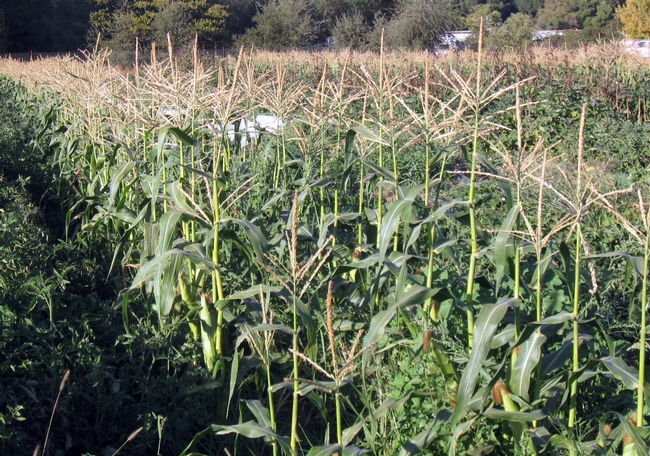Posts Tagged: corn
Drip-irrigation study sees ‘huge’ reduction in water, fertilizer use for sweet corn
Study by UCCE advisor in Imperial County also shows 5% increase in yield
A new study suggests that drip irrigation for sweet corn can significantly conserve water, reduce fertilizer use and boost crop yield in the low desert of California – and likely in other areas of California with similar conditions.
Although Imperial County is California's top sweet corn-producing county, with about 8,000 acres planted on average each year, irrigation methods for this crop have been rarely studied in this region (or anywhere else in the state), according to Ali Montazar, UC Cooperative Extension irrigation and water management advisor for Imperial, Riverside and San Diego counties.
Montazar conducted a study in the Imperial Valley over two crop seasons, 2020-21 and 2021-22, to demonstrate and quantify the potential benefits of switching to drip irrigation from the more common furrow irrigation method. The study, available in a recent issue of UC Agriculture and Natural Resources' Agricultural Briefs, will be published in a future issue of Vegetables West.
“I'm hoping with this project we can encourage growers to adopt it, because it seems very promising,” said Montazar, noting that drip irrigation is a “new practice” for sweet corn in California.
Among the 11 commercial sweet corn fields in the study over the 2021-22 season, the six that were under drip irrigation used, on average, 37% less water than the five under furrow irrigation. In absolute terms, the drip-irrigated fields saw an average water savings of 2.2 acre-feet per acre; for Montazar, who has studied drip for a variety of crops in the Imperial Valley, that was an astonishing result.
“I've worked with drip on processed onions, lettuce, alfalfa, spinach … we've never seen a figure like 2.2 acre-feet per acre, that's huge,” he said, attributing the dramatic drop-off to the high volume of water required to furrow-irrigate the sandy soil in the Imperial Valley.
More efficient irrigation also means less fertilizer is needed – a boon to the environment and Salton Sea water quality, as well as growers' bottom line. With fertilizer prices continuing to rise, sweet corn growers using drip could see a substantial 25% cost savings on fertilizer expenses – about $150 per acre less – compared to furrow irrigation, according to Montazar's study.
And by relieving plants of the stress from over- and under-irrigated conditions, drip irrigation helps keep soil moisture at its “sweet spot” – resulting in a 5% increase in marketable crop yield for sweet corn in the study.
“When we have a better, more efficient irrigation system, we can maintain soil moisture at a desired level, over time and space,” Montazar explained.
Because the benefits of drip appear to be linked to soil conditions (sandy loam, and other light soils), Montazar believes that this irrigation practice could deliver relatively similar water and fertilizer savings and improved crop yield in other regions across California, regardless of climactic differences.
“If you use drip in any part of the state, you have the benefits of drip – more uniform water application, more uniform fertilizer – that's not related to the desert,” he said. “That's part of the system's potential.”
Montazar plans to follow up on his preliminary study with additional research on sweet corn and drip irrigation during the 2022-23 crop season.
Corn smut for dinner tonight...yum!
I often look at foods and wonder, “Who’s idea was it to eat this?” Some foods just don’t look like they should be food, including huitlacoche.
Huitlacoche is corn smut — a fungus that often infects sweet corn during times of drought. It enters the plant through the ovaries, and replaces the corn kernels with large tumor-like spores that look like really ugly mushrooms. Farmers in the U.S. have spent millions of dollars trying to eradicate the infection. The UC Davis Student Farm has a bad case of corn smut this year, and it’s threatening to ruin their entire crop.
But it may not be such a bad thing. Often known as the Mexican truffle, huitlacoche is considered a delicacy in Mexico. In fact, the Aztecs used to purposely scratch their corn plant with a knife to encourage the growth of huitlacoche.
According to this article in the Huffington Post, huitlacoche may actually be more nutritious than the corn it infected. It’s full of protein, minerals, and other nutritious compounds that don’t always exist in the corn itself. It’s also more valuable than the corn itself — in a study conducted by University of Wisconsin, an ear of huitlacoche sold for approximately $1.20 and cost about 41 cents to produce. An ear of corn without the infection cost less than 10 cents to produce, but sold for only a few cents more.
Although it sells for approximately $20 per pound in Napa Valley, few American growers have converted to growing the fungus. Most American growers lack the resources needed for inoculation, and huitlacoche is highly perishable; however, demand is slowly increasing and several American growers have started growing the specialized crop.
Huitlacoche is typically found in tacos, quesadillas, tamales, and other traditional Mexican cuisine. In the U.S., it’s mostly found canned in Mexican grocery stores, and can occasionally be found in high-end restaurants or traditional Mexican restaurants. Want to give it a try? For suggestions of restaurants that serve the delicacy in the San Francisco Bay Area, read this blog at chowhound.com. Or if you’re really brave and want to cook it yourself, try including it as a side dish or making huitlacoche soup.
I was out at the UC Davis Student Farm this weekend looking for huitlacoche, and sure enough, about one in every 10 ears of corn had it. Though it could be profitable, the student farm has no intention of selling it this time around.
“We just don’t have the resources to harvest it, and we don’t have the market here to make it profitable” said Edwina King, the Market Garden Coordinator at the UCD Student Farm.
But that won’t stop some locals from getting excited about the crop. Jessica Myles, a UC Davis graduate student who helped me identify the fungus at the student farm, harvested some herself.
“I’m going to go home and cook it up and freeze it, I’m so excited!”
She’s promised to make me huitlacoche tamales. As curious as I am about trying it, I may have to close my eyes while I eat it. Stay tuned.
Survey identifies 19 produce candidates for a farm-to-WIC program
A new federal voucher that gives low-income women access to a range of fruits and vegetables could provide unique new marketing opportunities for California growers.
In 2009, the federal Special Supplemental Nutrition Program for Women, Infants and Children (WIC) began distributing monthly cash vouchers to low-income women with children to buy fruits and vegetables. The program reaches almost half of the infants and one-quarter of children under 5 years old in the United States.
A team of UC Cooperative Extension (UCCE) researchers and nutrition advisors has been exploring the possibility of developing a farm-to-WIC program that would link these low-income consumers with local growers. The purpose of such a program would be to increase the consumption of a wide variety of fresh produce, with a focus on locally grown produce when available.
UCCE conducted a survey of produce preferences and buying habits among WIC participants in Tulare, Alameda and Riverside counties in 2010. The full study is published in the January-March 2012 issue of California Agriculture journal.
Based on the results, the UCCE team developed a list of 19 produce items to promote in a possible new farm-to-WIC program. They are:
|
|
|
Although mustard greens and collards were not popular across all sites, the advisors gauged a potential market in Alameda County, so these were retained. Based on write-in responses, oranges were also added.
In California, which has the nation's largest WIC program, 82 local agencies serve about 1.43 million participants at 623 local centers, and WIC participants can redeem their monthly vouchers at 4,000 grocery stores statewide. About 40 percent shop at WIC-only stores, which stock and sell only WIC-authorized foods.
Stocking produce is relatively new to WIC-only stores; before rollout of new WIC food packages in October 2009, these stores were only required to stock limited amounts of fresh carrots. In the survey, most WIC participants (58 percent to 72.3 percent) responded that their preferred stores offered many choices, but fewer participants (18.5 percent to 41 percent) rated the produce quality as “excellent.” Key factors determining purchase decisions were produce quality and freshness, and nutrient value (vitamins and minerals). Cost was relatively less important, possibly because WIC participants procure the produce with the vouchers.
The list has served as a starting point for discussions with growers and WIC vendors.
“The survey showed that WIC participants were interested in purchasing fresh produce with better quality and more variety,” wrote lead author Lucia L. Kaiser, Cooperative Extension specialist in the UC Davis Department of Nutrition, and co-authors, in California Agriculture. “Some WIC participants that we surveyed said they avoided shopping at WIC-only stores in part because these interests were not met.”

A dish made with nopales (cactus pads).






